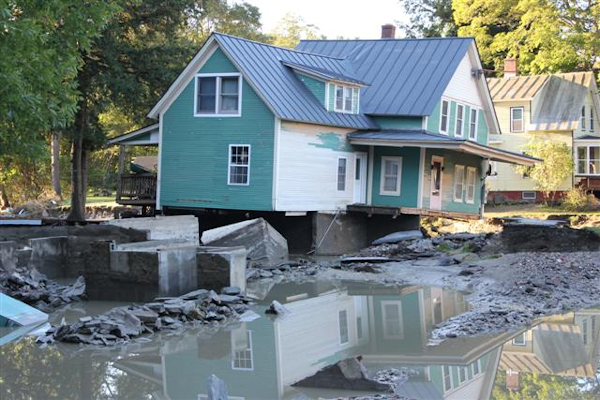SEJournal Online is the digital news magazine of the Society of Environmental Journalists. Learn more about SEJournal Online, including submission, subscription and advertising information.
 |
 |
| Houses in Bethel, Vermont, severely damaged by Hurricane Irene in 2011. Credit: USFWS. Photo: U.S. Fish and Wildlife Service Northeast via Flickr Creative Commons (Public domain). |
TipSheet: Property Risk Disclosure Reveals Reportable Environmental Threats
By Joseph A. Davis
Many homeowners already know that environmental woes can come from buying the wrong house. Renters worry, too. Reporters can help their audiences by coaching them on the environmental risks and problems to avoid.
Those of us with long memories can remember when newspapers had real estate sections. A showcase for lucrative real estate ads, few of those sections challenged the industry’s practices.
Perhaps we should not mourn them if we want to do journalism that helps readers.
Why it matters
Flood risk and lead paint are more than just headaches. They affect people’s health and safety. Homebuyers may — or may not — get information about these risks before they sign the contract.
State and local governments may
require some (but rarely all) of
these risks to be disclosed
ahead of real estate sales.
State and local governments may require some (but rarely all) of these risks to be disclosed ahead of real estate sales.
Let’s be frank: Home sellers and the agents who represent them don’t always have a motive to disclose things like that. Sellers will play up features like schools, shopping, transit, restaurants and so on. Drinking water problems? Not so much.
What some consumer advocates miss is how many environmental risks come with real estate purchases. This is why we have environmental journalists.
Story ideas
Here are some areas to explore:
- Disclosure requirements: Every state has different requirements, and you can find out about them from SOLD.com, a nationwide real estate business.
- Home inspectors: Whatever the legal environment near you, professional home inspectors know about it. Find them in your locality. Some may talk to you.
- Lead paint: Federal law requires disclosure of lead paint risks in real estate sales. The question of whether the risks have been adequately mitigated, however, can be tricky and subjective.
- Flood risk/history: Federal law does not require disclosure, but some 29 states do. Find out if your state is one of them. People anywhere can find out if a property lies in the Federal Emergency Management Agency-designated flood plain. But has it ever been flooded? How many times?
- Radon: Radon gas causes cancer. Produced by natural rock formations, it can seep into houses through basements, but can be mitigated fairly easily. Its presence varies by geographic area. Disclosure is not required federally, but the U.S. Environmental Protection Agency offers high-res maps. State laws, when they exist, may be fuzzy.
- Wildfire risk: Only California and Oregon require wildfire risk to be disclosed in real estate transactions. As climate heats the nation, wildfire disasters are more common. FEMA has mapped the risk. If residents in your community plan to live in a wildfire-risk area, find out what measures have been taken to reduce a house’s vulnerability.
- Lead in water: Lead service lines are common in older houses in many U.S. cities. Remember Flint? Only a few states require disclosure. Actually, the EPA and local utilities are still trying to figure out which areas have lead pipes. Many know.
- Drinking water: Some communities have contaminants in their source water, and even in their treated drinking water. Private wells, too. Home sellers are not required to disclose this. But the law does require utilities to disclose what’s in their treated water. Ask for your utility’s Consumer Confidence Report.
- Asbestos: Before the 1980s, asbestos (a toxic material) was commonly used in housing. Under a complex fabric of laws, it is now illegal at the federal level. But disclosure isn’t always required. If asbestos is in a prospective home, it may be better to encapsulate it than to remove it. Homebuyers get inspections from licensed contractors. Find them yourself and talk to them.
- Insurance and mortgage requirements: Mortgage banks and insurers may have requirements about some environmental risks. Ask them.
- Evacuation risks: Some environmental hazards may lead to evacuation orders. Consider wildfire, floods, hurricanes, nuclear accidents, chemical releases and other risks. Find out if the community has enough evacuation routes and robust plans for notification and evacuation.
- Air pollution: Disclosure isn’t required, but information is available. Is the building in a “nonattainment” area under the Clean Air Act? Near a landfill, incinerator or a Superfund site? In a “sacrifice zone”?
- Carbon monoxide: If a building is heated with gas or oil (or, rarely, other combustibles), toxic carbon monoxide may be released into the living space. Tuning or replacing the furnace may be in order. CO detectors are rarely required, but are inexpensive and available.
- Dam safety: Most dams are safe. But if a building is downstream of a large or old dam, check on the risks. Start with the National Inventory of Dams. If a nearby dam is rated “high” or “medium” hazard, there may be issues. It’s often hard, but try to find out about dam conditions, recent inspections, emergency action plans, etc. What you really want is the inundation map for the dam (if it is accurate and available).
Joseph A. Davis is a freelance writer/editor in Washington, D.C. who has been writing about the environment since 1976. He writes SEJournal Online's TipSheet, Reporter's Toolbox and Issue Backgrounder, and curates SEJ's weekday news headlines service EJToday and @EJTodayNews. Davis also directs SEJ's Freedom of Information Project and writes the WatchDog opinion column.
* From the weekly news magazine SEJournal Online, Vol. 9, No. 20. Content from each new issue of SEJournal Online is available to the public via the SEJournal Online main page. Subscribe to the e-newsletter here. And see past issues of the SEJournal archived here.












 Advertisement
Advertisement 



